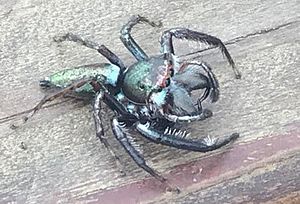Ascyltus facts for kids
Quick facts for kids Ascyltus |
|
|---|---|
 |
|
| Ascyltus pterygodes, the type species, on Maui | |
| Scientific classification |
|
| Kingdom: | Animalia |
| Phylum: | Arthropoda |
| Subphylum: | Chelicerata |
| Class: | Arachnida |
| Order: | Araneae |
| Infraorder: | Araneomorphae |
| Family: | Salticidae |
| Subfamily: | Salticinae |
| Genus: | Ascyltus Karsch, 1878 |
| Type species | |
| A. pterygodes (L. Koch, 1865)
|
|
| Species | |
|
10, see text |
|
Ascyltus spiders are a group of amazing jumping spiders. They belong to a family called Salticidae. A scientist named Ferdinand Karsch first described them in 1878. As of 2020, there are 10 known types of Ascyltus spiders.
These spiders use their excellent eyesight for many things. They use it to find a mate, hunt for food, and even to find their way around. Ascyltus spiders are usually medium to large in size. They often move slowly, but they can make super fast jumps! They jump when they move, hunt, or need to escape from danger.
Ascyltus spiders have four pairs of eyes, which means eight eyes in total! Their two front-middle eyes are the biggest and most important. A special thing about these spiders is their shiny, rainbow-colored upper body, called the carapace.
Contents
What Makes Ascyltus Spiders Special?
Ascyltus spiders are known for their medium to large size. You can tell them apart from other jumping spiders in the Pacific Ocean by their unique shiny, rainbow-colored carapace. This part of their body is often wider, even when they are young spiders.
Like all jumping spiders, Ascyltus spiders have eight eyes arranged in three rows. Their two large front-middle eyes are much bigger than the others. These big eyes help them see very well.
How Big Are They?
Male Ascyltus spiders are usually about 13 to 19 millimeters long. Female spiders are a bit bigger, averaging 16 to 20 millimeters in length.
Where Do They Live?
Most Ascyltus spiders live in a region called Oceania. This includes many islands across the Pacific Ocean, like the Hawaiian islands. They are found in a wide area across these islands.
What Do They Eat?
Ascyltus spiders are carnivores, which means they eat meat. Their diet mostly includes insects found in tropical areas. They are skilled hunters and catch most of their food by sneaking up on it. They enjoy eating flies, crickets, and small grasshoppers.
How Do They Hunt?
Ascyltus spiders rely a lot on their amazing eyesight to catch prey. Their side eyes help them track things that are moving. Their big front-middle eyes are like tiny telescopes, helping them stalk their prey from a distance.
These spiders have special ways of catching food. They use different moves depending on how far away their prey is.
- If the prey is far, they might align and pursue: they follow, run, and then stalk.
- If they spot something, they might orient: they become alert and swivel their bodies.
- When they are close enough, they capture: they crouch down and then jump to catch their meal!
Species of Ascyltus Spiders
As of December 2020, there are ten known species in the Ascyltus group. They are found only in Oceania, on the Pacific Islands, and Sulawesi:
- Ascyltus asper (Karsch, 1878) – Australia (New South Wales), New Caledonia
- Ascyltus audax (Rainbow, 1897) – Tuvalu (Funafuti)
- Ascyltus divinus Karsch, 1878 – Australia (Queensland), Fiji
- Ascyltus ferox (Rainbow, 1897) – Tuvalu (Funafuti)
- Ascyltus lautus (Keyserling, 1881) – New Guinea, Samoa
- Ascyltus minahassae Merian, 1911 – Indonesia (Sulawesi)
- Ascyltus opulentus (Walckenaer, 1837) – Tonga
- Ascyltus pterygodes (L. Koch, 1865) (type) – Pacific Is.
- Ascyltus rhizophora Berry, Beatty & Prószyński, 1997 – Fiji
- Ascyltus similis Berry, Beatty & Prószyński, 1997 – Fiji, Samoa

